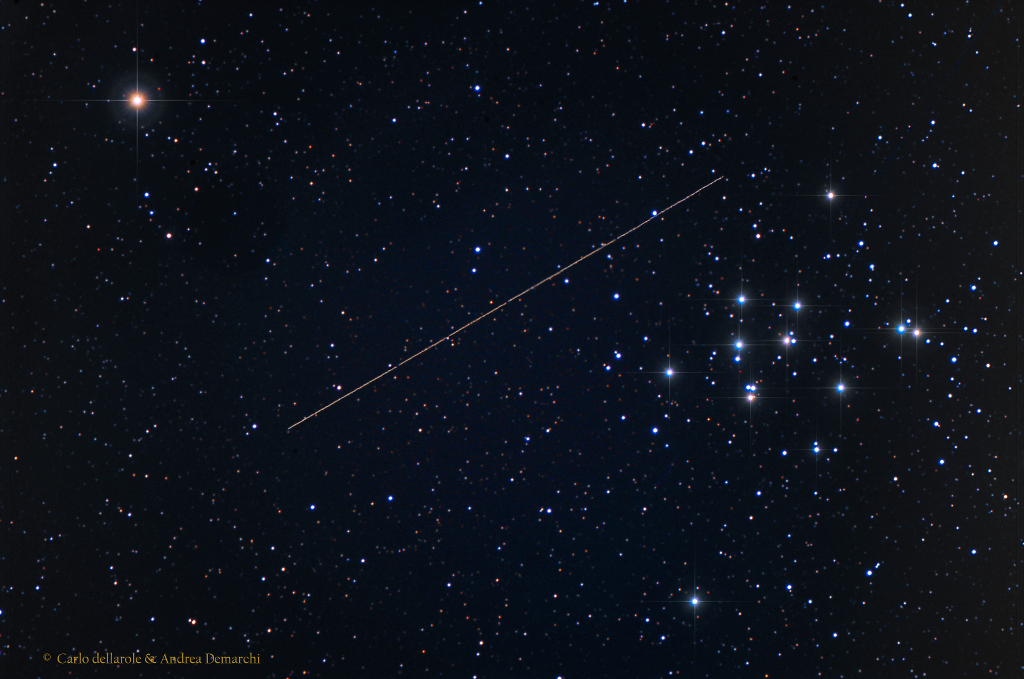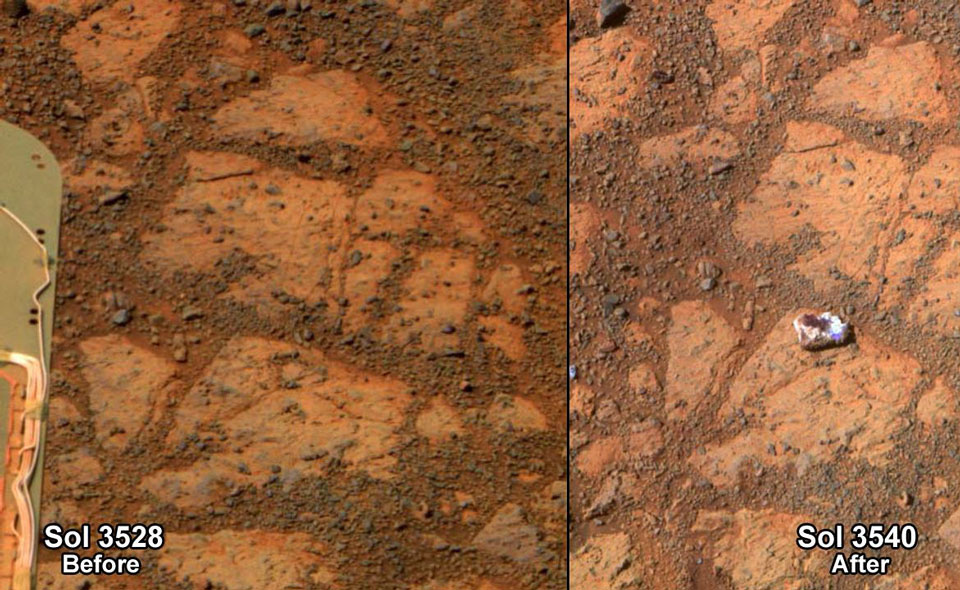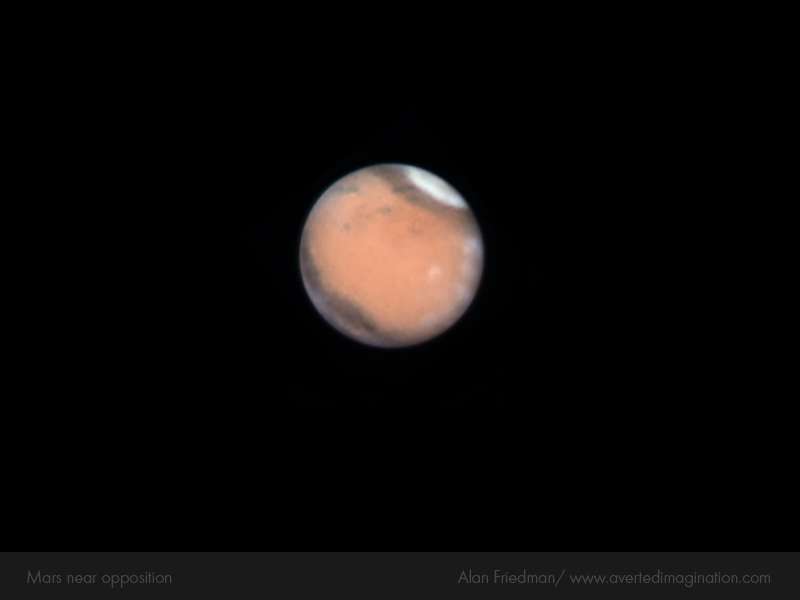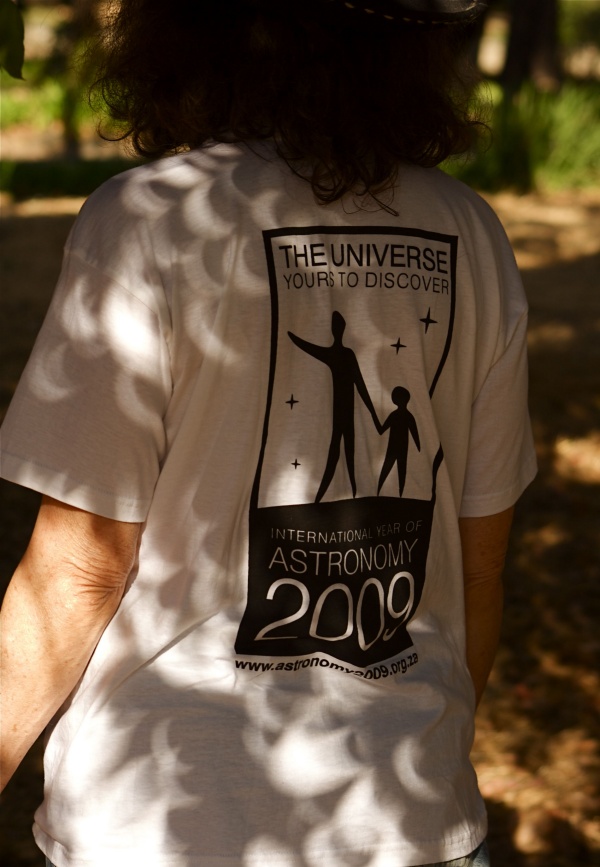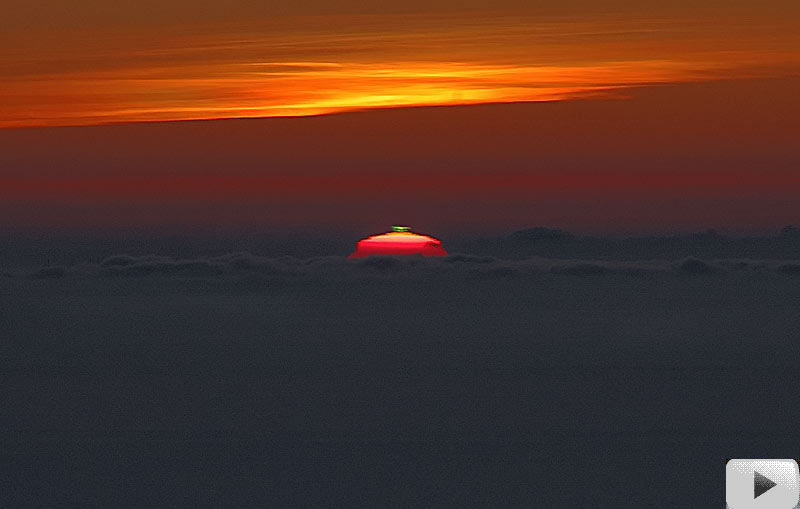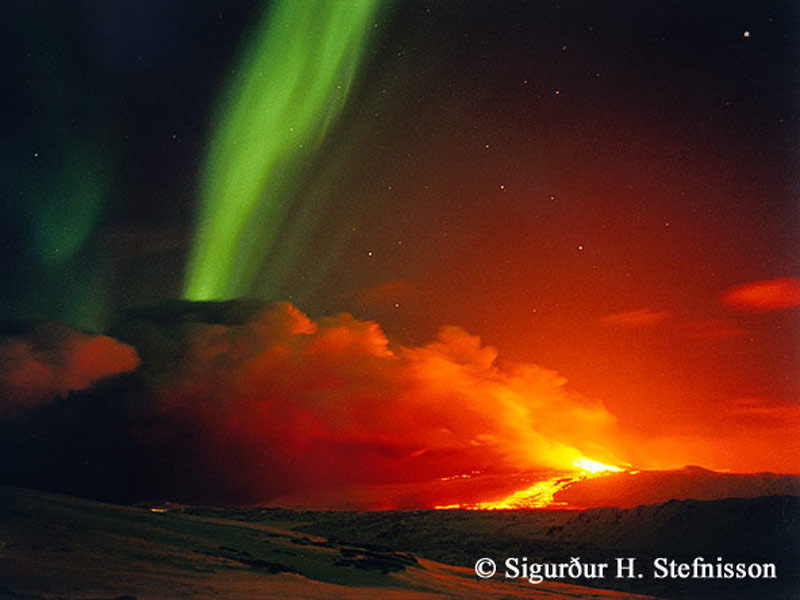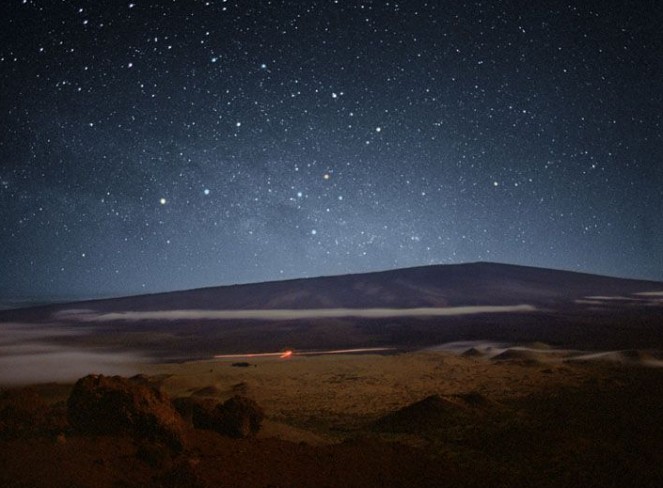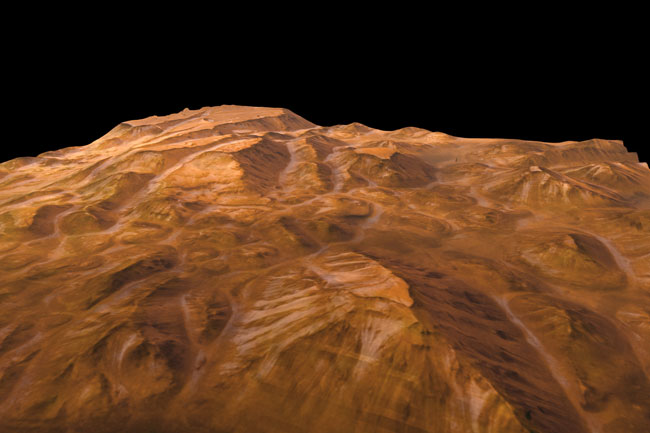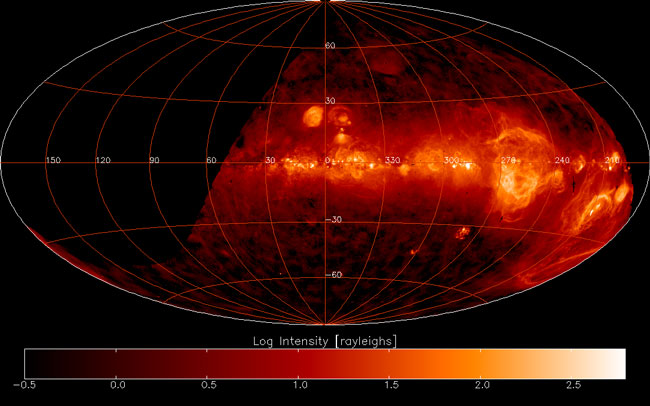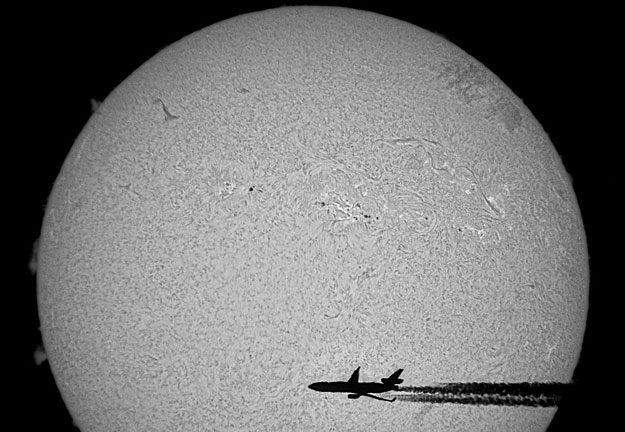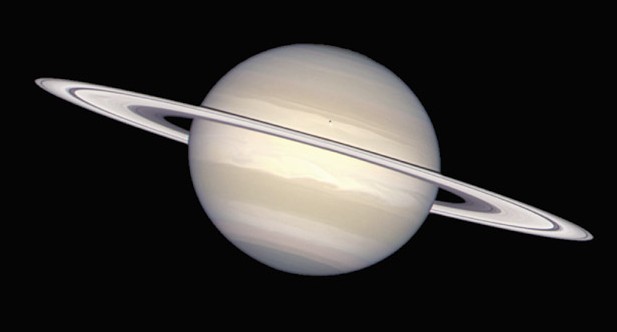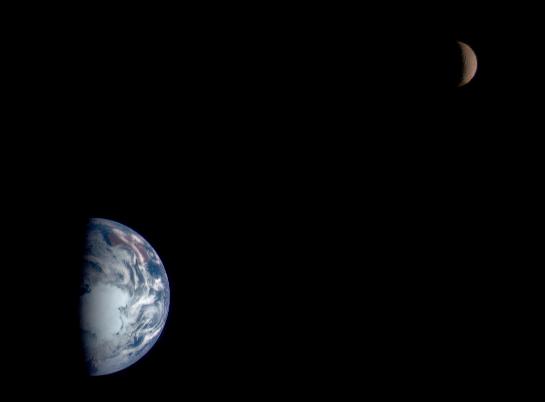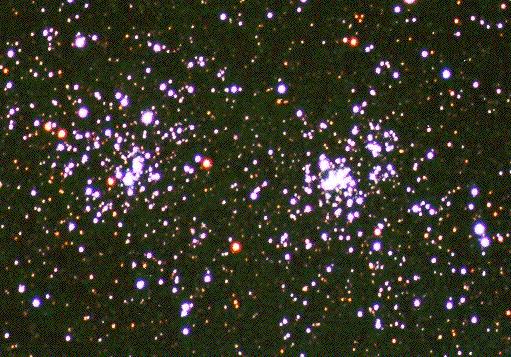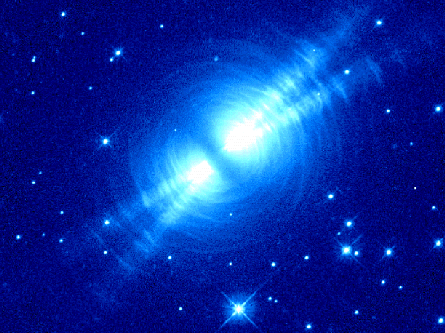| << Previous | Index | Next >> |
2015 On Monday, January 26, well-tracked asteroid 2004 BL86 made its closest approach, a mere 1.2 million kilometers from our fair planet. That's about 3.1 times the Earth-Moon distance or 4 light-seconds away. Moving quickly through Earth's night sky, it left this streak in a 40 minute long exposure on January 27 made from Piemonte, Italy. The remarkably pretty field of view includes M44, also known as the Beehive or Praesepe star cluster in Cancer. Of course, its close encounter with M44 is only an apparent one, with the cluster nearly along the same line-of-sight to the near-earth asteroid. The actual distance between star cluster and asteroid is around 600 light-years. Still, the close approach to planet Earth allowed detailed radar imaging from NASA's Deep Space Network antenna at Goldstone, California and revealed the asteroid to have its own moon.
2014 What if a rock that looked like a jelly donut suddenly appeared on Mars? That's just what happened in front of the robotic Opportunity rover currently exploring the red planet. The unexpectedly placed rock, pictured above, was imaged recently by Opportunity after not appearing in other images taken as recently as twelve Martian days (sols) before. Given the intriguing mystery, the leading explanation is somewhat tame -- the rock was recently scattered by one of the rover's tires. Even so, the rock's unusual light tones surrounding a red interior created interest in its composition -- as well as causing it to be nicknamed Jelly Donut. A subsequent chemical analysis showed the rock has twice the abundance of manganese than any other rock yet examined -- an unexpected clue that doesn't yet fit into humanity's understanding of the Martian geologic history. Opportunity, just passing its 10-year anniversary on Mars, continues to explore the Murray Ridge section of the rim of 22-kilometer wide Endeavor Crater.
2013
Click to play embedded YouTube video.
Video Credit: NASA
2012 Where did all the stars go? What used to be considered a hole in the sky is now known to astronomers as a dark molecular cloud. Here, a high concentration of dust and molecular gas absorb practically all the visible light emitted from background stars. The eerily dark surroundings help make the interiors of molecular clouds some of the coldest and most isolated places in the universe. One of the most notable of these dark absorption nebulae is a cloud toward the constellation Ophiuchus known as Barnard 68, pictured above. That no stars are visible in the center indicates that Barnard 68 is relatively nearby, with measurements placing it about 500 light-years away and half a light-year across. It is not known exactly how molecular clouds like Barnard 68 form, but it is known that these clouds are themselves likely places for new stars to form. In fact, Barnard 68 itself has been found likely to collapse and form a new star system. It is possible to look right through the cloud in infrared light.
2011
2010 Mars is at opposition tonight, opposite the Sun in planet Earth's sky. Of course, it will be easy to spot because Mars appears close to tonight's Full Moon, also opposite the Sun in Earth's night sky in the constellation Cancer. For this opposition, Mars remains just over 99 million kilometers away, not a particularly close approach for the Red Planet. Still, this sharp view of Mars recorded on January 22nd is an example of the telescopic images possible in the coming days. The planet's whitish north polar cap is at the upper right. Mars' tiny red disk is about 14 arcseconds in angular diameter, less than 1/100th the diameter of the Full Moon.
2009 Of course, everyone is concerned about what to wear to a solar eclipse. This is a great example though, especially for the first eclipse of the International Year of Astronomy 2009. In the picture, recorded during the January 26 solar eclipse from the grounds of the South African Astronomical Observatory at Cape Town, repeated images of the eclipse adorn a well-chosen shirt. The effect is familiar to eclipse enthusiasts as small gaps, commonly between leaves on trees, act as pinhole cameras to generate multiple recognizable images of the eclipse. From the Cape Town perspective, the solar eclipse was a partial one, with a maximum of about 65% of the Sun covered. But along a track extending across the Indian Ocean and western Indonesia the eclipse became annular, the solar disk briefly appearing as a fiery ring around the silhouetted Moon.
2008 What does Mars look like from here? Last September, before hiking across rugged and slippery terrain to reach its winter hibernation point, the robotic Spirit rover climbed a small plateau known as Home Plate and captured the spectacular vista pictured above. Part of the curious flat-topped Home Plate is visible as the light colored landscape across the panorama's foreground. On the image left, visible about eight kilometers in the distance, is Grissom Hill, while on the left foreground is rock strewn Tsiolkovski Ridge. On the right, at about 800 meters distant, is Husband Hill, already explored by Spirit and notable as the highest point visible in the westward looking panorama. In the inset is a close-up of a tiny motionless feature informally dubbed Little Bigfoot that has drawn some attention for it superficial appearance to a humanoid life form. Tenacious image explorers might locate Little Bigfoot towards the front left of the high resolution panorama. Spirit successfully reached its energy-conserving winter haven in December.
2007 How could the Sun turn green? Difficult to observe, the momentary green flash above the rising or setting sun has been documented as a phenomenon caused by the atmospheric bending or refraction of sunlight. Like a weak prism, the Earth's atmosphere breaks white sunlight into colors, bending red colors slightly and green and blue colors through increasingly larger angles. When the sky is clear, a green flash just above the sun's edge can sometimes be seen for a second or so, when the sun is close to a distant horizon. Still, from a site atop Mt. Autore (altitude 1,850 meters) in Italy astrophotographer Danilo Pivato captured this dramatic green flash movie. The time between frames varies from over one minute in the beginning to about one second as the flash becomes visible. (Animation here.)
2006 Sometimes both heaven and Earth erupt. In Iceland in 1991, the volcano Hekla erupted at the same time that auroras were visible overhead. Hekla, one of the most famous volcanoes in the world, has erupted at least 20 times over the past millennium, sometimes causing great destruction. The last eruption occurred only six years ago but caused only minor damage. The green auroral band occurred fortuitously about 100 kilometers above the erupting lava. Is Earth the Solar System's only planet with both auroras and volcanos?
2005 Gazing across this gorgeous skyscape, the Southern Cross and stars of the constellation Centaurus are seen above the outline of Mauna Loa (Long Mountain), planet Earth's largest volcano. Unfamiliar to sky gazers north of about 25 degrees north latitude, the Southern Cross, constellation Crux, is near the horizon to the left of Mauna Loa's summit. A compact constellation of bright stars, the long axis of the cross conveniently points south toward the southern celestial pole. The top of the cross is marked by the lovely pale red star Gamma Crucis, which is in fact a red giant star about 120 light-years distant. Stars of the grand constellation Centaurus almost engulf the Southern Cross with blue giant Beta Centauri, and yellowish Alpha Centauri, appearing as the brightest stars to the left of Gamma Crucis. At a distance of 4.3 light-years, Alpha Centauri, the closest star to the Sun, is actually a triple star system which includes a star similar to the Sun. But what caused the reddish streaks in the foreground of this time exposure? Alas, it is the mundane glow of lights from cars (not molten lava!) traveling the road to Hilo, Hawaii.
2004 Europe's Mars Express satellite has started returning detailed color images of the red planet. The first of the current armada to arrive at Mars, the orbiting satellite will photograph the entire Martian surface to a resolution of 10 meters or higher, map the mineral composition to 100 meter resolution, and investigate the global circulation of the atmosphere. Pictured above is a 3D perspective of the first image released from this satellite -- a stunning computer reconstruction of part of the Valles Marineris region, a canyon nicknamed the Grand Canyon of Mars. In reality, Valles Marineris is four times longer and five times deeper than its Arizona counterpart. The above image shows a portion of Valles Marineris roughly 65 kilometers across, detailing many ridges and valleys. Mars Express is scheduled to continue to send back images for at least a full Martian year.
2003 The Horsehead Nebula is one of the most famous nebulae on the sky. It is visible as the dark indentation to the red emission nebula seen above and to the right of center in the above photograph. The bright star on the left is located in the belt of the familiar constellation of Orion. The horse-head feature is dark because it is really an opaque dust cloud which lies in front of the bright red emission nebula. Like clouds in Earth's atmosphere, this cosmic cloud has assumed a recognizable shape by chance. After many thousands of years, the internal motions of the cloud will alter its appearance. The emission nebula's red color is caused by electrons recombining with protons to form hydrogen atoms. Also visible in the picture are blue reflection nebulae, which preferentially reflect the blue light from nearby stars.
2002 A robotic telescope with red sunglasses in Chile has been photographing the entire southern sky for years. The result, shown above, is the most complete sky map of the most common visible light emitted from the most abundant element in our Galaxy: hydrogen. A very specific red color emitted by warm ionized hydrogen was observed. Although spectacular emission nebulas glow brightly in this type of red light (H-alpha), a diffuse amount of warm hydrogen is spread throughout our Galaxy and its glow nicely indicates not only where darker hydrogen and other gasses may be located, but also the sometimes- complex history of interstellar gas. Gas tracking the plane of our Galaxy runs across the center, and huge gas clouds, some of which are the expanding shells of long dead stars, are also visible. The above map was derived from the Southern H-Alpha Sky Survey Atlas (SHASSA) and shows that our entire Galaxy is one big emission nebula, albeit at a quite faint level.
2001 Sometimes, good planes come to those who wait. Experienced solar photographer Thierry Lagault had noticed planes crossing in front of the Sun from his home in suburban Paris. He then got the idea for the above photograph, but had to wait through many near misses. About two weeks ago, he got his wish: a jet crossed directly in front of the Sun when his solar imaging equipment was set up. The resulting image, shown above, was taken in a specific color of red light called Hydrogen-Alpha, and the picture's contrast has been digitally enhanced. Dark prominences can be seen lacing the Sun's busy surface. The airplane is an MD-11.
2000 What could you see approaching Saturn aboard an interplanetary cruise ship? Your view would likely resemble this subtly shaded image of the gorgeous ringed gas giant. Processed by the Hubble Heritage project, the picture intentionally avoids overemphasizing color contrasts and presents a natural looking Saturn with cloud bands, storms, nearly edge-on rings, and the small round shadow of the moon Enceladus near the center of the planet's disk. Of course, seats were not available on the only ship currently enroute - the Cassini spacecraft, launched in 1997 and scheduled to arrive at Saturn in the year 2004. After an extended cruise to a world 1,400 million kilometers from the Sun, Cassini will tour the Saturnian system, conducting a remote, robotic exploration with software and instruments designed by denizens of planet Earth. But where is Cassini now? Still about 980 million kilometers from Saturn, last Sunday the spacecraft flew by asteroid 2685 Masursky.
1999 Reckoning dates by Universal Time, the next full moon will be on Sunday, January 31. Since the last was on January 2nd, Sunday's full moon will be the second this month. Perhaps only in recent times, the term "Blue Moon" has come to mean the second full moon in a month, joining a list of folklore names for the brightest lunar phase. Aren't Blue Moons extremely rare? Well, the moon's phases repeat every 29.5 days and most months have 30 or 31 days, so a Blue Moon is certainly possible if not a common event. In fact, the next (and last) Blue Moon in 1999 will occur in March, leaving February without a full moon at all. This sharp telescopic view of a waning crescent moon was recorded on January 12th by the European Southern Observatory's new WFI camera.
1998 This evocative mosaic image of the Earth-Moon system was recorded by NASA's Near Earth Asteroid Rendezvous (NEAR) spacecraft earlier this month. The relative sizes shown are appropriate for viewing both the Earth and Moon from a distance of about 250,000 miles, although the apparent brightness of the Moon has been increased by about a factor of five for the sake of appearances. This space-based perspective is a unique one, the bland and somber Lunar Southern Hemisphere contrasting strongly with blue oceans, swirling clouds, and the bright icy white continent of Antarctica on planet Earth. Though its lack of atmosphere and oceans make it relatively dull looking, the Earth's moon is one of the largest moons in the solar system - even larger than the planet Pluto. During this recent flyby of the Earth-Moon system, the NEAR spacecraft used Earth's gravity to deflect it towards its ultimate destination, the Asteroid 433 Eros. It is scheduled to arrive at Eros in January 1999.
1997 Most star clusters are singularly impressive. But open clusters NGC 869 and NGC 884 are doubly impressive. Also known as "h and chi Persei", this rare double cluster, shown above, is bright enough to be seen from a dark location without even binoculars. Although their discovery surely predates written history, the "double cluster" was notably cataloged by the Greek astronomer Hipparcos. The clusters are over 7000 light years distant toward the constellation of Perseus, but are separated by only hundreds of light years.
1996 The dramatic and mysterious looking object revealed in this Hubble Space Telescope image is known as the Egg Nebula. It is an aging star about 3,000 lightyears distant, entering its Planetary Nebula phase of evolution. Surrounded by an expanding cloud of gas and dust, a dense cocoon of dust (seen as the dark band running diagonally across the center) encloses the star itself and blocks it from direct view. The searchlight appearance is created as light from the star shines more easily through the thinner parts of the cocoon. Dust particles in the expanding cloud scatter and reflect the starlight making the beams visible. The sharpness of the HST image reveals a wealth of detail which will help to understand this complex and spectacular part of the stellar lifecycle.
| << Previous | Index | Next >> |
